Loss-of-function mutations of ROOT HAIR DEFECTIVE3 suppress root waving, skewing, and epidermal cell file rotation in Arabidopsis
- PMID: 15908600
- PMCID: PMC1150390
- DOI: 10.1104/pp.105.059774
Loss-of-function mutations of ROOT HAIR DEFECTIVE3 suppress root waving, skewing, and epidermal cell file rotation in Arabidopsis
Abstract
Wild-type Arabidopsis (Arabidopsis thaliana L. Heynh.) roots growing on a tilted surface of impenetrable hard-agar media adopt a wave-like pattern and tend to skew to the right of the gravity vector (when viewed from the back of the plate through the medium). Reversible root-tip rotation often accompanies the clockwise and counterclockwise curves that form each wave. These rotations are manifested by epidermal cell file rotation (CFR) along the root. Loss-of-function alleles of ROOT HAIR DEFECTIVE3 (RHD3), a gene previously implicated in the control of vesicle trafficking between the endoplasmic reticulum and the Golgi compartments, resulted in an almost complete suppression of epidermal CFR, root skewing, and waving on hard-agar surfaces. Several other root hair defective mutants (rhd2-1, rhd4-1, and rhd6-1) did not exhibit dramatic alterations in these root growth behaviors, suggesting that a generalized defect in root hair formation is not responsible for the surface-dependent phenotypes of rhd3. However, similar alterations in root growth behavior were observed in a variety of mutants characterized by defects in cell expansion (cob-1, cob-2, eto1-1, eto2-1, erh2-1, and erh3-1). The erh2-1 and rhd3-1 mutants differed from other anisotropic cell expansion mutants, though, by an inability to respond to low doses of the microtubule-binding drug propyzamide, which normally causes enhanced left-handed CFR and right skewing. We hypothesize that RHD3 may control epidermal CFR, root skewing, and waving on hard-agar surfaces by regulating the traffic of wall- or plasma membrane-associated determinants of anisotropic cell expansion.
Figures
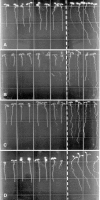


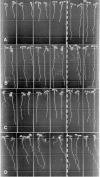
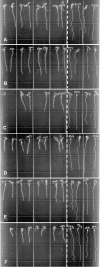
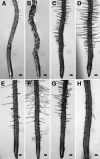
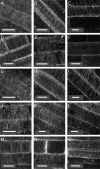
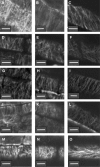
Similar articles
-
TNO1, a TGN-localized SNARE-interacting protein, modulates root skewing in Arabidopsis thaliana.BMC Plant Biol. 2017 Apr 11;17(1):73. doi: 10.1186/s12870-017-1024-4. BMC Plant Biol. 2017. PMID: 28399805 Free PMC article.
-
WVD2 and WDL1 modulate helical organ growth and anisotropic cell expansion in Arabidopsis.Plant Physiol. 2003 Feb;131(2):493-506. doi: 10.1104/pp.015966. Plant Physiol. 2003. PMID: 12586874 Free PMC article.
-
Arabidopsis ROOT HAIR DEFECTIVE3 is involved in nitrogen starvation-induced anthocyanin accumulation.J Integr Plant Biol. 2015 Aug;57(8):708-21. doi: 10.1111/jipb.12320. Epub 2015 Feb 2. J Integr Plant Biol. 2015. PMID: 25494721
-
Waving and skewing: how gravity and the surface of growth media affect root development in Arabidopsis.New Phytol. 2007;176(1):37-43. doi: 10.1111/j.1469-8137.2007.02184.x. Epub 2007 Aug 10. New Phytol. 2007. PMID: 17692076 Review.
-
Emerging aspects of ER organization in root hair tip growth: lessons from RHD3 and Atlastin.Plant Signal Behav. 2011 Nov;6(11):1710-3. doi: 10.4161/psb.6.11.17477. Epub 2011 Nov 1. Plant Signal Behav. 2011. PMID: 22057320 Free PMC article. Review.
Cited by
-
A network of genes associated with poplar root development in response to low nitrogen.Plant Signal Behav. 2016 Aug 2;11(8):e1214792. doi: 10.1080/15592324.2016.1214792. Plant Signal Behav. 2016. PMID: 27449227 Free PMC article.
-
Non-canonical peroxisome targeting signals: identification of novel PTS1 tripeptides and characterization of enhancer elements by computational permutation analysis.BMC Plant Biol. 2012 Aug 11;12:142. doi: 10.1186/1471-2229-12-142. BMC Plant Biol. 2012. PMID: 22882975 Free PMC article.
-
In vivo interference with AtTCP20 function induces severe plant growth alterations and deregulates the expression of many genes important for development.Plant Physiol. 2009 Mar;149(3):1462-77. doi: 10.1104/pp.108.126136. Epub 2008 Dec 17. Plant Physiol. 2009. PMID: 19091878 Free PMC article.
-
Dissecting the role of CHITINASE-LIKE1 in nitrate-dependent changes in root architecture.Plant Physiol. 2011 Nov;157(3):1313-26. doi: 10.1104/pp.111.181461. Epub 2011 Sep 23. Plant Physiol. 2011. PMID: 21949212 Free PMC article.
-
Skewing in Arabidopsis roots involves disparate environmental signaling pathways.BMC Plant Biol. 2017 Feb 1;17(1):31. doi: 10.1186/s12870-017-0975-9. BMC Plant Biol. 2017. PMID: 28143395 Free PMC article.
References
-
- Andeme-Onzighi C, Sivaguru M, Judy-March J, Baskin T, Driouich A (2002) The reb1-1 mutation of Arabidopsis alters the morphology of trichoblasts, the expression of arabinogalactan-proteins and the organization of cortical microtubules. Planta 215: 949–958 - PubMed
-
- Ausubel F, Brent R, Kingston R, Moore D, Seidman J, Smith J, Struhl K (1994) Current Protcols in Molecular Biology—Updates 1994-2002. John Wiley and Sons, New York
-
- Baskin T, Betzner A, Hoggart R, Cork A, Williamson R (1992) Root morphology mutants in Arabidopsis thaliana. Aust J Plant Physiol 19: 427–437
-
- Baskin T, Wilson J, Cork A, Williamson R (1994) Morphology and microtubule organization in Arabidopsis roots exposed to oryzalin or taxol. Plant Cell Physiol 35: 935–942 - PubMed
Publication types
MeSH terms
Substances
Grants and funding
LinkOut - more resources
Full Text Sources
Other Literature Sources
Molecular Biology Databases

